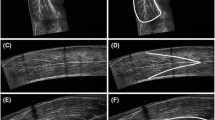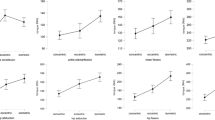Abstract
The present study examined the effect of agonist activation and antagonist co-activation on the shape of the knee extension moment–angle relationship in adults and children. Isometric knee extension maximum voluntary contractions (MVCs) were performed at every 5° of knee flexion between 55° and 90° (full extension = 0°) by ten men, ten women, ten boys and ten girls. For each trial, the knee extensors’ voluntary activation level was quantified using magnetic stimulation and the level of antagonist co-activation was quantified from their electromyographical activity. Peak MVC moment was greater for men (264 ± 63 N m) than women (177 ± 60 N m), and greater for adults than children (boys 78 ± 17 N m, girls 91 ± 28 N m) (p < 0.01). The agonistic activation level was greater for adults (~85%) than children (~70%). Similarly, antagonist co-activation was greater for adults than children, but relative to the agonist moment there were no differences between groups (all groups 7–8%). Correcting the peak moment for agonist and antagonist activation levels resulted in moments produced by fully activated agonist muscles of 334 ± 83, 229 ± 70, 114.2 ± 32 and 147 ± 46 N m, for men, women, boys and girls, respectively. Although correcting for shifts in joint angle during contraction altered the angle of peak moment by ~10° (p < 0.01), the peak moment occurred at ~60° for all groups. Changes in tendon stiffness, muscle size and architecture, and the pattern of the moment arm–angle relationship may in combination occur so that as children develop and mature into adults the shape of the moment–angle relationship is not altered.



Similar content being viewed by others

References
Ahmad CS, Clark AM, Heilmann N, Schoeb JS, Gardner TR, Levine WN (2006) Effect of gender and maturity on quadriceps-to-hamstring strength ratio and anterior cruciate ligament laxity. Am J Sports Med 34:370–374. doi:10.1177/0363546505280426
Arampatzis A, Karamanidis K, De Monte G, Stafilidis S, Morey-Klapsing G, Brüggemann G (2004) Differences between measured and resultant joint moments during voluntary and artificially elicited isometric knee extension contractions. Clin Biomech (Bristol, Avon) 19:277–283. doi:10.1016/j.clinbiomech.2003.11.011
Baltzopoulos V, Kellis E (1998) Isokinetic strength during childhood and adolescence. In: Van Praagh E (ed) Pediatric anaerobic performance. Human Kinetics, Champaign, IL, pp 225–240
Bampouras TM, Reeves ND, Baltzopoulos V, Maganaris CN (2006) Muscle activation assessment: effects of method, stimulus number, and joint angle. Muscle Nerve 34:740–746. doi:10.1002/mus.20610
Baratta R, Solomonow M, Zhou BH, Letson D, Chuinard R, D’Ambrosia R (1988) Muscular coactivation. The role of the antagonist musculature in maintaining knee stability. Am J Sports Med 16:113–122. doi:10.1177/036354658801600205
Bassa E, Patikas D, Kotzamanidis C (2005) Activation of antagonist knee muscles during isokinetic efforts in prepubertal and adult males. pediatric exercise science, pp 171–181 (total no. of pages 111)
Behm D, Power K, Drinkwater E (2001) Comparison of interpolation and central activation ratios as measures of muscle inactivation. Muscle Nerve 24:925–934. doi:10.1002/mus.1090
Belanger AY, McComas AJ (1989) Contractile properties of human skeletal muscle in childhood and adolescence. Eur J Appl Physiol Occup Physiol 58:563–567. doi:10.1007/BF00418500
Gans C, Bock W (1965) The functional significance of muscle architecture: a theoretical analysis. Ergeb Anat Entwicklungsgesch 38:115–142
Kanehisa H, Ikegawa S, Tsunoda N, Fukunaga T (1995) Strength and cross-sectional areas of reciprocal muscle groups in the upper arm and thigh during adolescence. Int J Sports Med 16:54–60. doi:10.1055/s-2007-972964
Kellis E, Baltzopoulos V (1997) The effects of antagonist moment on the resultant knee joint moment during isokinetic testing of the knee extensors. Eur J Appl Physiol Occup Physiol 76:253–259. doi:10.1007/s004210050244
Kellis E, Unnithan VB (1999) Co-activation of vastus lateralis and biceps femoris muscles in pubertal children and adults. Eur J Appl Physiol Occup Physiol 79:504–511. doi:10.1007/s004210050545
Kubo K, Kanehisa H, Kawakami Y, Fukanaga T (2001) Growth changes in the elastic properties of human tendon structures. Int J Sports Med 22:138–143. doi:10.1055/s-2001-11337
Marginson V, Eston R (2001) The relationship between torque and joint angle during knee extension in boys and men. J Sports Sci 19:875–880. doi:10.1080/026404101753113822
Newman SA, Jones G, Newham DJ (2003) Quadriceps voluntary activation at different joint angles measured by two stimulation techniques. Eur J Appl Physiol 89:496–499. doi:10.1007/s00421-003-0836-0
O’Brien T, Reeves N, Baltzopoulos V, Jones D, Maganaris C (2008) Assessment of voluntary muscle activation using magnetic stimulation. Eur J Appl Physiol 104:49–55. doi:10.1007/s00421-008-0782-y
Paasuke M, Ereline J, Gapeyeva H (2000) Twitch contraction properties of plantar flexor muscles in pre- and post-pubertal boys and men. Eur J Appl Physiol 82:459–464. doi:10.1007/s004210000236
Parker DF, Round JM, Sacco P, Jones DA (1990) A cross-sectional survey of upper and lower limb strength in boys and girls during childhood and adolescence. Ann Hum Biol 17:199–211. doi:10.1080/03014469000000962
Reeves ND, Maganaris CN, Narici MV (2003) Effect of strength training on human patella tendon mechanical properties of older individuals. J Physiol 548:971–981
Reeves ND, Narici MV, Maganaris CN (2004) Effect of resistance training on skeletal muscle-specific force in elderly humans. J Appl Physiol 96:885–892. doi:10.1152/japplphysiol.00688.2003
Round JM, Jones DA, Honour JW, Nevill AM (1999) Hormonal factors in the development of differences in strength between boys and girls during adolescence: a longitudinal study. Ann Hum Biol 26:49–62. doi:10.1080/030144699282976
Tanner JM (1962) Growth at adolescence. Blackwell Scientific Publications, London
Vogel HG (1983) Age dependence of mechanical properties of rat tail tendons (hysteresis experiments). Aktuelle Gerontol 13:22–27
Wood LE, Dixon S, Grant C, Armstrong N (2004) Elbow flexion and extension strength relative to body or muscle size in children. Med Sci Sports Exerc 36:1977–1984. doi:10.1249/01.MSS.0000145453.02598.7E
Zajac FE (1989) Muscle and tendon: properties, models, scaling, and application to biomechanics and motor control. Crit Rev Biomed Eng 17:359–411
Author information
Authors and Affiliations
Corresponding author
Rights and permissions
About this article
Cite this article
O’Brien, T.D., Reeves, N.D., Baltzopoulos, V. et al. The effects of agonist and antagonist muscle activation on the knee extension moment–angle relationship in adults and children. Eur J Appl Physiol 106, 849–856 (2009). https://doi.org/10.1007/s00421-009-1088-4
Accepted:
Published:
Issue Date:
DOI: https://doi.org/10.1007/s00421-009-1088-4



